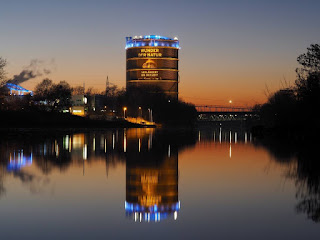 |
| (C) Gasometer Oberhausen |
My contribution are some images of a Zinnia haageana flower in large prints, on display in their exhibition area below that 20 meter large earth globe, demonstrating the difference between our human vision, as well as a video presentation shown on LCD panel which originates from the BBC series "How to grow a planet - The hidden World of UV" which has several of my VIS and UV images of different flowers in it.
Printed Zinnia (in UV light) in background, video display in foreground:
approx 3m / 9ft wide Zinnia image in ultraviolet light:
Zinnia haageana: Triptych of Human Vision, UV, Simulated Bee Vision (left to right):
The exhibit shows in total some 150 large images and video presentations by the most famous nature photographers and is not only visually stunning, but also highly educative and suited for interested individuals as well as families and schools. Go have a look, it will be well worth it!
There is still a printed book available about it: Wunder der Natur, Die Intelligenz der Schöpfung ISBN/EAN: 9783837514629 (in German language)
I have written about that exhibit previously HERE
Stay tuned, more will follow on that fascinating subject...
